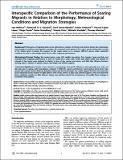Por favor, use este identificador para citar o enlazar a este item:
http://hdl.handle.net/10261/143406COMPARTIR / EXPORTAR:
 SHARE SHARE
 CORE
BASE CORE
BASE
|
|
| Visualizar otros formatos: MARC | Dublin Core | RDF | ORE | MODS | METS | DIDL | DATACITE | |

| Título: | Interspecific comparison of the performance of soaring migrants in relation to morphology, meteorological conditions and migration strategies |
Autor: | Mellone, Ugo; Limiñana, Rubén CSIC ORCID; López-López, Pascual; Urios, Vicente | Fecha de publicación: | 2012 | Editor: | Public Library of Science | Citación: | PLoS ONE 7(7): e39833 (2012) | Resumen: | [Background]: Performance of migrating birds can be affected by a number of intrinsic and extrinsic factors like morphology, meteorological conditions and migration strategies. We compared travel speeds of four raptor species during their crossing of the Sahara desert. Focusing the analyses on this region allows us to compare different species under equivalent conditions in order to disentangle which factors affect migratory performance. [Methodology/Principal Finding]: We tracked raptors using GPS satellite transmitters from Sweden, Spain and Italy, and evaluated their migratory performance at both an hourly and a daily scale. Hourly data (flight speed and altitude for intervals of two hours) were analyzed in relation to time of day, species and season, and daily data (distance between roosting sites) in relation to species, season, day length and tailwind support. [Conclusions/Significance]: Despite a clear variation in morphology, interspecific differences were generally very small, and did only arise in spring, with long-distance migrants (>5000 km: osprey and Western marsh-harrier) being faster than species that migrate shorter distances (Egyptian vulture and short-toed eagle). Our results suggest that the most important factor explaining hourly variation in flight speed is time of day, while at a daily scale, tailwind support is the most important factor explaining variation in daily distance, raising new questions about the consequences of possible future changes in worldwide wind patterns. | Descripción: | This is an open-access article distributed under the terms of the Creative Commons Attribution License.-- et al. | Versión del editor: | https://doi.org/10.1371/journal.pone.0039833 | URI: | http://hdl.handle.net/10261/143406 | DOI: | 10.1371/journal.pone.0039833 | Identificadores: | doi: 10.1371/journal.pone.0039833 e-issn: 1932-6203 |
| Aparece en las colecciones: | (IREC) Artículos |
Ficheros en este ítem:
| Fichero | Descripción | Tamaño | Formato | |
|---|---|---|---|---|
| MigrationStrategie.PDF | 838,44 kB | Adobe PDF |  Visualizar/Abrir |
CORE Recommender
PubMed Central
Citations
18
checked on 16-mar-2024
SCOPUSTM
Citations
78
checked on 11-abr-2024
WEB OF SCIENCETM
Citations
74
checked on 27-feb-2024
Page view(s)
232
checked on 18-abr-2024
Download(s)
199
checked on 18-abr-2024

